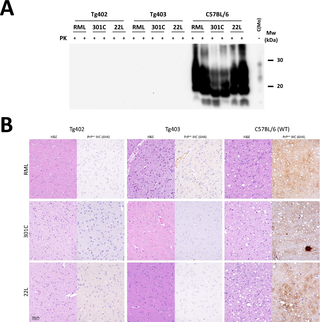PLoS Pathogens ( IF 5.5 ) Pub Date : 2017-11-13 , DOI: 10.1371/journal.ppat.1006716 Natalia Fernández-Borges , Beatriz Parra , Enric Vidal , Hasier Eraña , Manuel A. Sánchez-Martín , Jorge de Castro , Saioa R. Elezgarai , Martí Pumarola , Tomás Mayoral , Joaquín Castilla

|
One of the characteristics of prions is their ability to infect some species but not others and prion resistant species have been of special interest because of their potential in deciphering the determinants for susceptibility. Previously, we developed different in vitro and in vivo models to assess the susceptibility of species that were erroneously considered resistant to prion infection, such as members of the Leporidae and Equidae families. Here we undertake in vitro and in vivo approaches to understand the unresolved low prion susceptibility of canids. Studies based on the amino acid sequence of the canine prion protein (PrP), together with a structural analysis in silico, identified unique key amino acids whose characteristics could orchestrate its high resistance to prion disease. Cell- and brain-based PMCA studies were performed highlighting the relevance of the D163 amino acid in proneness to protein misfolding. This was also investigated by the generation of a novel transgenic mouse model carrying this substitution and these mice showed complete resistance to disease despite intracerebral challenge with three different mouse prion strains (RML, 22L and 301C) known to cause disease in wild-type mice. These findings suggest that dog D163 amino acid is primarily, if not totally, responsible for the prion resistance of canids.
中文翻译:

揭示犬科动物抵抗病毒疾病的关键
ions病毒的特征之一是它们能够感染某些物种,但不能感染其他物种,而resistant病毒抗性物种由于具有破译易感性决定因素的潜力而备受关注。以前,我们开发了不同的体外和体内模型来评估被误认为对病毒感染具有抵抗力的物种(如Leporidae和Equidae家族的成员)的敏感性。在这里,我们进行体外和体内方法来了解犬科未解决的低病毒敏感性。根据犬病毒蛋白(PrP)的氨基酸序列进行研究,并进行结构分析在计算机中,确定了独特的关键氨基酸,这些氨基酸的特征可以协调其对病毒病的高抗性。进行了基于细胞和大脑的PMCA研究,突出了D163氨基酸与蛋白质错误折叠倾向的相关性。还通过产生带有这种取代的新型转基因小鼠模型进行了研究,尽管这些小鼠在脑内受到已知会在野生型小鼠中引起疾病的三种不同的小鼠ion病毒株(RML,22L和301C)的脑内攻击,但仍显示出对疾病的完全抗性。这些发现表明,狗D163氨基酸主要(如果不是全部)负责犬科动物对病毒的抗性。











































 京公网安备 11010802027423号
京公网安备 11010802027423号